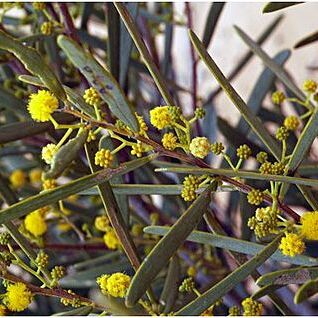An evergreen shrub up to 3-4 m tall. It spreads out about 3 m across. It usually has a rounded shape. The stem is erect and slender. It has graceful weeping branches. The leaves (phyllodes) are narrow and oblong. They have a small hard point. They are tapered at both ends. They can be 10 cm long by 2 cm wide. (When the tree grows on limestone the leaves are more broad and with a bluish-green colour.) They are greyish green. The flowers are orange balls. They are about 0.5 cm across. There can be one to 5 flowers in the angles where leaves join. The pods are hard and 5-10 cm long. They are constricted between the seeds. They are also brittle breaking between the seeds. The seeds are rather hard and with a red or yellow section where they join the pod.


